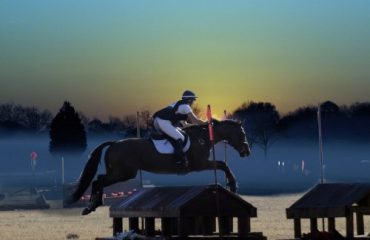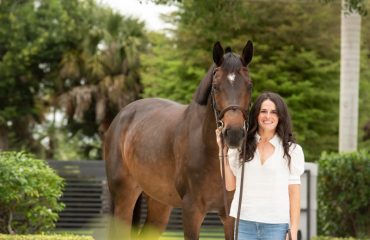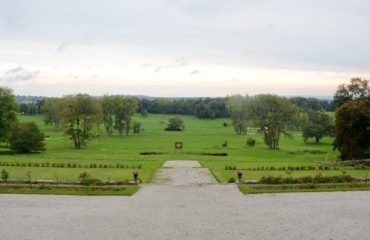By Laura Scaletti
Portraits by Melissa Fuller
Beatrice de Lavalette lives by the motto, “No matter what happens to you, you decide your future.” On March 22, 2016, Beatrice’s life changed in an instant when she was standing just a few feet away from a suicide bomber at the Brussels Airport in Zaventem, Belgium. The most gravely injured survivor of the airport bombing, Beatrice’s incredible will and determination not only enabled her to be rescued from the airport, but also led her to the 2020 Paralympic Games in Tokyo.
Born into an equestrian family, Beatrice attended her first pony gymkhana at just 3 weeks old so her parents could watch one of her brothers. “My mom loves horses, so she taught me and my brothers to love them, too. By the time I came around, my brothers were playing horse-ball. I started riding Shetlands without stirrups before age 3. By age 7, I was playing horse-ball, and then I moved up to dressage and hunters,” Beatrice said.
At 14 years old, Beatrice moved from France, where she was born and raised, to Belgium, where her father had gotten a new job. Homesick for France, Beatrice needed a distraction to keep her spirits up. Thankfully, it was at this time that she met her mare DeeDee. “She needed a girl to love, and I needed a best friend. I decided to dedicate myself to dressage with DeeDee,” Beatrice said. This relationship would become crucial when Beatrice once again needed a distraction.
March 22
March 22 started as a regular travel day for 17-year-old Beatrice. Her parents, Nicolas and Elizabeth, had recently bought a house in Florida, so she was planning on spending her spring break in the States helping them unpack and set up the new house.
“I was a total teenager walking through the airport; skateboard in one hand, phone in the other, and my headphones in. I had just gotten off the phone with my brother, who was in Utah at the time, and told him it was 3 a.m. and he needed to go to bed,” Beatrice said. “Moments later, the bomb went off. I never made it past the departure hall in the airport.”
Suddenly everything went black, and Beatrice was knocked out by the explosion. When she came to, everything was dark, dusty and smoky. “I looked down at my body and saw my right leg was at a right angle. I didn’t see my left leg, but I could still feel it, so I knew it was there. I was in shock and had so much adrenaline running through my body, I felt no pain,” Beatrice said.
As rescuers started to triage victims, Beatrice was tagged red, meaning not likely to survive. In the midst of the tagging, Beatrice helped a victim on the ground next to her. “I turned my head and saw the lady next to me. Her hair was on fire and out of pure instinct, I turned over and patted out the flames with my hand without even thinking about it,” Beatrice said. Eventually rescuers came and took the lady, leaving Beatrice behind.
“As my hearing came back, I started hearing people calling for help and it got louder and louder. I thought, I should probably be doing the same; I know I’m in bad shape, but I’m going to survive this. So, I started calling for help in both French and English,” Beatrice said. “A bunch of first responders passed by me, but luckily I found the strength to raise my right hand in the air and a firefighter who was putting out flames nearby saw me and told the others, ‘There’s one over here.’”
Rescuers put Beatrice on a backboard and evacuated her from the airport. “I kept telling the rescuers, ‘I’m really tired; I just want to go to sleep.’ They repeatedly told me, ‘Don’t go to sleep, you can’t close your eyes,’” Beatrice said. “Eventually I passed out and my brain shut off the conscious part of me.”
Recovery
Beatrice opened her eyes again a month later when she awoke from her coma. It was then Beatrice realized the extent of her injuries. “My injuries were the worst of anyone who survived. I ended up losing both of my lower legs, had second- and third-degree burns on 35% of my body, major internal injuries, and had a spinal cord injury. We don’t know what caused the spinal cord injury; I have so much shrapnel in my body and metal doesn’t mix well with an MRI,” Beatrice said.
After being in a coma for a month, Beatrice’s muscles had all atrophied. “Rehab started right away, as they wanted to get me back in shape as soon as possible. First, we started with passive movements with my legs and then worked with my arms,” Beatrice said. “As time went on, rehab got harder and the doctors were trying to wean me off of the pain meds. As I got used to it, it wasn’t so bad.” Beatrice would end up spending four months in the ICU and an additional six weeks in inpatient rehab.
Although she wasn’t a kid who loved school, one of Beatrice’s first goals in the hospital was to get back to school. “I knew I wanted to finish high school with my friends; that took precedence over all my other choices. Even though I knew life would never be the same, going to school was a way to inch back to normalcy,” she said.
Beatrice’s teachers were fully supportive of her goal and came to the hospital to teach her and get her caught up in her studies. “They were the sweetest. I was so bored in the hospital, and they came during their free time and helped me to make sure I wouldn’t fall behind,” Beatrice said. “I finished junior year in the hospital and graduated on time with my classmates.”
Another visitor to the hospital who made a huge impact in Beatrice’s future was American Ambassador to Belgium Denise Campbell Bauer. Denise visited Beatrice twice, once while she was in a coma and then two months after she awoke from the coma. Denise began asking Beatrice about her plans for the future and if she was going to continue participating in sports.
“She asked me if I had heard about the Paralympics. I hadn’t, so she explained what they were, and we saw that Rio 2016 was about to happen. We then looked up the next Games and saw it was Tokyo 2020 and I said, ‘I will be there. No matter what happens, I’m going to Tokyo,’” Beatrice said. “That was my big goal that kept me going for years. I had something to strive for and something I really wanted to do.”
Return to Riding
After daydreaming about DeeDee throughout her hospital stay, Beatrice finally was able to sit on her mare five months following the bombing. “We went to visit DeeDee and by chance my friend Claire, who was taking care of her, was riding her. My friends and barn mates insisted I was going to get on, too, and I didn’t complain. Four people got me on DeeDee and we rode double, with my friend literally hugging me and everyone else hovering next to me in case I fell,” Beatrice said.
 Beatrice in her wheelchair quickly became a regular fixture again at her barn in Belgium, slowly building enough strength to ride without spotters on the ground. She competed in her first para show in April 2017. After graduating from high school, Beatrice headed to California for college, where she also had the opportunity to go to the Naval Medical Center in San Diego for additional rehabilitation thanks to special Pentagon approval.
Beatrice in her wheelchair quickly became a regular fixture again at her barn in Belgium, slowly building enough strength to ride without spotters on the ground. She competed in her first para show in April 2017. After graduating from high school, Beatrice headed to California for college, where she also had the opportunity to go to the Naval Medical Center in San Diego for additional rehabilitation thanks to special Pentagon approval.
Settling into her new life in California, Beatrice needed a trainer and was given a recommendation to work with Shayna Simon. “She had never worked with a para athlete before, but she took it by the horns and rocked it. Shayna saw me doing wheelies in my wheelchair and was like, OK, I’ll follow that. We clicked from the very beginning,” Beatrice said. DeeDee soon arrived from Belgium and the two women got to work.
With Shayna, her beloved DeeDee and the muscles she was rebuilding at the Navy Medical Center, Beatrice was ready to tackle her first CPEDI event in January 2019. “For our first international competition, it went well. The chef d’equipe of the para team told me DeeDee was a great horse to learn how to ride on again and get my first couple of international shows, but if I wanted to go to Tokyo I’d need a new horse,” Beatrice said. “Shayna was going to Europe to try horses and ended up bringing two home for me.”
Unfortunately, while Shayna was finding Beatrice a new mount, there was a bump in the road when Beatrice got a pressure sore that landed her in the hospital for eight months. “In addition to the sore, we also found out I had osteomyelitis, a bone infection, which was likely a result of the bombing. It had lain dormant until I got the pressure sore. I was fortunate to still be able to compete in the 2019 Para Dressage Championships in Tryon, North Carolina. Despite having just gotten out of the hospital, I had a great ride on Clark,” Beatrice said.
After a strong performance at the Championships, the team coach told Beatrice she had a chance to go to Tokyo—however, she’d have to spend the winter 2020 season in Florida. “We made the move to Florida and then got stuck there when the COVID-19 pandemic hit,” Beatrice said.
Paralympian
In May 2020, the official postponement of the Paralympics was announced leaving the athletes crushed as they knew they’d all have to requalify for the 2021 edition of the games. By the time everything calmed down, Beatrice had acquired a new horse, Clarc. “He was already a parahorse in Europe, albeit a higher-level one, so when he got to the States we were able to start competing relatively quickly,” she said.
Thankfully, it didn’t take long for Beatrice to find her groove on Clarc and she earned herself a spot on Team USA after a good showing in Munich and at the final qualifying show in Tryon in June 2021. “When I found out I was on the team, I didn’t cry, but I was really happy. I had imagined myself being on the team from the very beginning, so even though it was out of my hands with selectors choosing the team, I had always imagined myself on the list,” she said.
Beatrice not only competed in the Tokyo Paralympics, but she was also the first one in the arena to kick off the Grade II competition, laying down an impressive test that gave her a fifth-place finish. “I figured if I’m going to go first, might as well set the bar high instead of freaking out. Competing there was surprisingly not as stressful as I thought it would be. I knew I was ready and remained calm the whole day,” Beatrice said.
With COVID restrictions in full force, Beatrice and her fellow Paralympians didn’t get the complete Paralympics experience; there was no exploring Tokyo. Nonetheless it was a memorable time. “The rules were very strict—if you were caught outside the village or venue, you got sent home without even being able to pack your bags. Obviously, we never took that risk; we were very good,” Beatrice said. “Just being around hundreds of para-athletes and representing Team USA was an unforgettable experience.”
One of Beatrice’s favorite moments from the Games was watching her teammates win medals. First, Roxanne Trunnel won an individual gold, then Roxanne, Rebecca Hart and Kate Shoemaker captured the team bronze. It’s that camaraderie Beatrice believes makes the para-dressage community special. “We really give each other the support we need; you’re never going through anything alone. It could be horse related, life related, it doesn’t matter; if you’re going through something we’re going to be there for you,” Beatrice said.
One of the first people to embrace Beatrice, as a newbie to the para-dressage world, was veteran team member Rebecca Hart. A four-time Paralympian herself, Rebecca immediately lent her support to Beatrice. “She was really excited to see me do great things,” Beatrice said. “Having her support and everyone else’s has been really cool.”
In addition to being a Paralympian in 2021, Beatrice also won the FEI’s Against All Odds Award, which is given to someone who has pursued their equestrian ambitions despite a physical handicap or extremely difficult personal circumstances. “It shows me that everything I had done the previous five years had been seen and people realized how much work I’d put into it,” Beatrice said.
With a new partner, Sixth Sense, aka Sensei, Beatrice has set her sights higher. At the 2022 World Championship, she was part of the team that brought home the bronze medal for the USA. Next up will be the Paris 2024 Paralympics. “This year, with head coach Michel Assouline’s assistance, we made the decision to let Shayna step back and concentrate on her own development. I am so grateful to her for making me the rider I am today!” Beatrice said. “Starting in September I will be training with Jennifer Baumert, who is based in Wellington.”
Beatrice hopes her story can help inspire others to embrace their own dreams. “A dream of going to the Olympics can take you to the Olympics,” she said. “Never give up on yourself or your dreams, as you never know how far they will take you.”
For more information visit BeaParathlete.org and follow Beatrice on Instagram @Beatriceldl
Photos by Melissa Fuller, melissafullerphotography33.mypixieset.com













